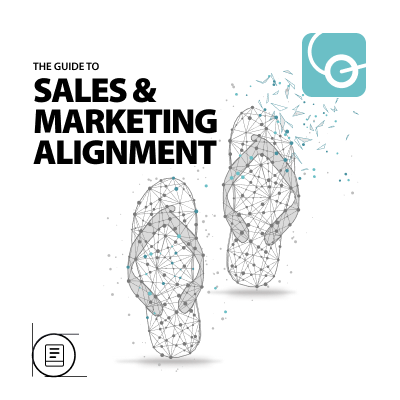Sales used to lead the sales conversation. But in today’s AI-driven, digital-first world, buyers are in control. They’re researching silently, comparing suppliers instantly, and choosing who will get the RFQ before a human even gets involved. Here's how your sales team can align their strategy with a new reality.
When sales teams held the power
Sales teams once engaged with a known universe of contacts in contract manufacturing. Buyer needs were predictable, sales cycles were stable. Deals were closed through in-person meetings, long-standing relationships, and technical persuasion.
But then global competition exploded, tech cycles accelerated, and a new generation of buyers arrived - armed with information and an entirely different set of expectations.
The digital turning point
The digital revolution plugged OEMs into a vast global network of supplier information. Websites, forums, spec sheets, and reviews became the first stop for buyers, rather than a sales rep. Suddenly, prospective customers could identify, vet, and shortlist partners without ever picking up the phone.
Contract manufacturers responded by moving online. They invested in SEO, built content libraries, and developed inbound marketing strategies to attract and convert traffic.
Sales teams began to rely on digital assets to support prospecting and relationship-building.
Hypercompetition has changed the sales challenge
In this digital era, competition has gone global, and B2B buyer behaviour has responded in kind.
When we interviewed Neil Sharp, Director of Corporate Marketing at ESCATEC for this article, he described the change he had seen over his professional life in the EMS sector:
“In the past, decision-makers often chose partners based on geographic convenience. Flight times and travel ease played a major role. But the digital era has erased those boundaries. Today’s buyers have access to a global pool of EMS providers at their fingertips, and they’re doing far more homework before making contact."
The buyer's journey is more complex today
Decision-making has grown more complex. Customers are weighing not just price but innovation, resilience, and compliance. B2B buying criteria are more considered and 'emotional' than they've been before:
Source: Dentsu
And the manufacturing sales cycle is longer as a result:
%20(1).webp?width=1200&height=486&name=Infographic-6%20(1)%20(1).webp)
Meanwhile, according to Gartner, more people are involved in the buying process than ever:
 Research shows the buyer’s journey is increasingly digital, fragmented, and confused. It resembles more of a maze than a linear path, making workflows harder than ever to define and automate:
Research shows the buyer’s journey is increasingly digital, fragmented, and confused. It resembles more of a maze than a linear path, making workflows harder than ever to define and automate:
.webp?width=1200&height=800&name=B2B-Manufacturing-buying-decisions-have-become-complex%20(2).webp)
"The rise of digital platforms has enabled EMS companies to showcase not just their capabilities, but their culture, values, and ways of working. As a result, marketing is no longer just a support function it now plays a central, strategic role in shaping perception, guiding the buyer journey, and showcasing the EMS offering in ways that were unthinkable just a few years ago.”
- Neil Sharp, ESCATEC
A new generation of buyers are shunning your sales teams
To add insult to injury, your buyers don't want to talk to you:
- 75% of B2B buyers prefer a largely rep-free experience.
Source: Gartner, “Future of Sales” Research, 2022 - 67–75% of the buyer’s journey is now completed digitally.
Source: Gartner, “The B2B Buyer’s Journey,” 2022–2023 - Buyers only spend 5–6% of their time with any one sales rep.
Source: Gartner, “The New B2B Buying Journey and Its Implications for Sales" - 65% of Millennials and 61% of Gen Z prefer self-discovery over traditional engagement.
Source: Forrester, "The Myth of the Millennial B2B Buyer,”
This isn’t just a generational shift - it’s a systemic one. Today’s customers don’t want to be sold to. They want speed, clarity, and control over their buying process.
But, while a new generation of buyers may favour self-discovery, they still crave curated experiences. For complex purchase processes, they need extensive bespoke guidance and support.
Which is why they love AI.
How AI changed the world
It may seem like a decade ago, but ChatGPT has only been in the public domain for three years.
The AI tool was first released in 2022, revolutionising not only how content is created but how it’s consumed.
And the effect on sales and marketing teams has been enormous.
Many companies discovered they could dramatically scale content output. White papers, FAQs, technical blogs, and capability summaries could be produced quickly and in vast quantities.
The result? A tidal wave of content that all looked suspiciously the same.
How AI became the ultimate content filter
But then buyers started using the tool to overcome their information overload.
Instead of visiting five supplier websites, they’d 'just ask ChatGPT':
“Who are the best UK-based contract manufacturers for sustainable medical device production?”
Increasingly, these tools could analyse, rank, and explain choices in seconds.
And soon, AI agents will go even further:
- Conducting tailored research on the buyer's behalf
- Interpreting uploaded spec sheets
- Recommending suppliers
- And triggering outreach only when confidence is high
This is the dawn of an agentic era - where your buyers are assisted not just by information, but by intelligent, autonomous co-pilots:
Is your sales strategy ready for the rise of the agents?
The evolution of the buyer journey
| Traditional (Pre-digital) |
Modern (Digital era) |
Age of AI (Now and next) |
|
|---|---|---|---|
| Information access | Sales-controlled: brochures, spec sheets on request | Self-directed research: websites, reviews, digital content | Smart discovery: AI-curated content, predictive search, and agent-led exploration |
| Sales rep involvement | Front-loaded: buyers engaged sales early for all info | Delayed: reps only engaged once buyers had done their homework | AI-qualified: AI chatbots and agents handle early interactions; human reps step in at high-impact points |
| Preferred engagement | In-person meetings, site tours, and phone calls | Digital-first: web self-service, remote demos, virtual tours | Hyper-personalised: AI guides interactions, tailors experiences to individual buyer needs |
| Research stage | Minimal: limited pre-call info | Deep: 60–75% of research completed before contacting sales | Predictive: AI identifies behaviour patterns and delivers tailored content in real-time on the buyer’s terms |
| Decision complexity | Simpler: fewer stakeholders, cost-led | Complex: 6–10 stakeholders, decisions based on cost, resilience, ESG, innovation | Streamlined: AI tools help sellers decode stakeholder needs, orchestrate messages, and guide buyers through internal consensus-building |
| Generational preference | Boomers/Gen X: comfort with traditional sales | Millennials/Gen Z: digital natives, favouring online self-service | Adaptive: AI adjusts channel, tone, and content based on generation, persona, and stage |
Sources : Gartner, McKinsey, Forrester, Google B2B Insights, and LinkedIn B2B Buyer Report, 2023–24
What sales needs to be now: moving from gatekeeper to guide
In the AI-powered buyer's journey, access to information is no longer the problem. Your prospects can compare capabilities, accreditations, lead times, and even cultural fit with a single prompt.
AI tools like ChatGPT, Gemini, and Perplexity can synthesise reviews, summarise technical specs, and generate shortlist criteria in seconds.
But information doesn’t equal impact
As Jeremy Knight, CEO of Equinet Media, puts it:
“We’re moving from the age of information, where knowledge was power, into the age of influence, where belief drives decisions and inspiration builds loyalty.”
And this is precisely the new battleground for contract manufacturers:
Not being found, but being chosen.
Not just showing up in search, but showing up in the mind of prospects and customers when they think of your sector
So, what sales strategies will work?
To win trust and influence decisions today, sales must adapt its strategies and tools.
Here’s what that looks like in practice:
Building influence through strategic content
The groundwork for sales today isn’t about mailing brochures or manning sales booths - it’s about building buyer belief with all the digital tools available.
- Highlight differentiation early: Use anonymised case studies, engineering insights, and sustainability proof points to show why you’re not just capable, but uniquely right.
- Produce POV-driven content: Sales leaders should share regular commentary on LinkedIn - hot takes, lessons learned from the factory floor, and perspectives on industry trends (think reshoring, EV supply chains, ESG compliance).
- Collaborate with marketing to co-create content: Use customer FAQs, sales objections, and tender requirements as inputs for high-impact blogs, video explainers, and decision-stage assets. Think about personalising your brand through hosting high impact webinars. Speak to the unique needs of your audience. Clip up your insights and share them.
Align sales and marketing
AI-driven buyers move quickly - and silently. Without tight sales and marketing alignment, you'll miss them entirely.
- Create shared visibility of the buyer journey: Use CRM and marketing automation platforms to track digital signals—downloads, site visits, email opens—and trigger timely sales follow-ups.
- Define shared KPIs: Align on revenue contribution, lead conversion rates, and account progression, not just MQL volume or call activity.
- Build a feedback loop: Sales teams should share real-time intel (new objections, product feedback, emerging trends) with marketing to inform agile content updates and campaign direction.
Use AI as a sales force multiplier, not a crutch
AI is not here to replace sales teams - it’s here to remove the grunt work and amplify the human moments that close deals.
- Automate qualification: Use chatbots, web forms, or voice assistants to capture high-intent leads and prioritise follow-up based on behaviour, not guesswork.
- Personalise outreach: Use AI tools to tailor email intros, social messages, or proposals based on the buyer’s business, pain points, and language preferences.
- Enable insight-led selling: AI can monitor account-level intent, industry signals, and competitor mentions - arming your sales team with timely, contextual insights.
Manufacturing marketers have been behind the AI curve
When it comes to using AI in marketing, manufacturers have been behind the curve, typically using it as means of playing catch up in content creation rather than embedding it deep into their strategy or marketing tool kit.
But Neil Sharp notes that for most EMS providers, AI has not yet found it's strategic feet in their marketing plans or practice:
"AI is changing the rules when it comes to being found and heard. It allows EMS providers to connect with the right audience more intelligently and efficiently - but it also raises the bar. The digital space is more crowded than ever, and breaking through the noise now demands consistent, high-value content that’s rooted in long-term strategy, not quick wins. "
Becoming the brand buyers believe in
In an age where AI efficiently handles the "what" – the facts, figures, and comparisons – the human element of sales must focus on the "why."
Buyers seek more than just fast answers; they crave conviction, confidence, and the belief that you are the right partner to help them innovate, scale, and de-risk their operations.
"Traditionally, EMS providers haven’t seen themselves as brands—but that’s changing. In a highly competitive, globalised market, branding and content have become essential tools for building trust and differentiation."
- Neil Sharp, ESCATEC
Accelerating alignment between sales and buyers in the age of AI
But as AI continues to reshape the buyers journey, simply digitising old sales processes isn't enough. As we've seen, it requires a fundamental rethinking of our approach.
Let's leave the final word to Neil Sharp, at ESCATEC, who has been at the vanguard of marketing in the EMS space for the last twenty years:
"This shift isn’t just about tools or tactics; it requires a change in mindset at the top. The EMS companies that will lead the future are those whose boards recognise that what worked in the past no longer applies, and who empower their marketing teams to play a strategic, sustained role in driving visibility, credibility, and growth.”


